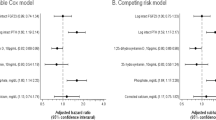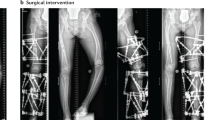Abstract
Autosomal recessive osteopetrosis (OP) is characterized by insufficient osteoclast activity resulting in defective bone resorption and marked increase in skeletal mass and density. OP has been successfully treated with hematopoietic cell transplantation (HCT), secondary to engraftment of donor-derived functioning osteoclasts resulting in remodeling of bone and establishment of normal hematopoiesis. Although hypercalcemia is a common presenting feature of OP, it may be observed following HCT due to engraftment of osteoclasts differentiated from the hematopoietic precursors. To characterize hypercalcemia after HCT—who is at risk, onset, duration and response to treatment—we evaluated 15 patients with OP treated at the University of Minnesota from 2000 to 2009. Hypercalcemia, defined as any single calcium >11.0 mg/100 ml after the first transplant, was found in 40% of patients. Median onset of hypercalcemia was 23 days and the duration was 2–24 days. Hypercalcemia was more common in patients older than 2 years of age at the time of HCT. Treatment with hydration, furosemide and s.c. calcitonin resolved hypercalcemia and resulted in no severe adverse events. In conclusion, hypercalcemia is common in patients with OP within the first 4 weeks after HCT, and more likely in older patients. Isotonic saline, furosemide and s.c. calcitonin were well-tolerated and effective treatments in our study population.
This is a preview of subscription content, access via your institution
Access options
Subscribe to this journal
Receive 12 print issues and online access
$259.00 per year
only $21.58 per issue
Buy this article
- Purchase on Springer Link
- Instant access to full article PDF
Prices may be subject to local taxes which are calculated during checkout
Similar content being viewed by others
References
Tolar J, Teitelbaum SL, Orchard PJ . Osteopetrosis. N Engl J Med 2004; 351: 2839–2849.
Teitelbaum SL, Coccia PF, Brown DM, Kahn AJ . Malignant osteopetrosis: a disease of abnormal osteoclast proliferation. Metab Bone Dis Relat Res 1981; 3: 99–105.
Teitelbaum SL . Bone resorption by osteoclasts. Science 2000; 289: 1504–1508.
Coccia PF . Cells that resorb bone. N Engl J Med 1984; 310: 456–458.
Glorieux FH, Pettifor JM, Marie PJ, Delvin EE, Travers R, Shepard N . Induction of bone resorption by parathyroid hormone in congenital malignant osteopetrosis. Metab Bone Dis Relat Res 1981; 3: 143–150.
Dorantes LM, Mejia AM, Dorantes S . Juvenile osteopetrosis: effects on blood and bone of prednisone and a low calcium, high phosphate diet. Arch Dis Child 1986; 61: 666–670.
Key Jr LL, Ries WL, Rodriguiz RM, Hatcher HC . Recombinant human interferon gamma therapy for osteopetrosis. J Pediatr 1992; 121: 119–124.
Key L, Carnes D, Cole S, Holtrop M, Bar-Shavit Z, Shapiro F et al. Treatment of congenital osteopetrosis with high-dose calcitriol. N Engl J Med 1984; 310: 409–415.
Tolar J, Bonfim C, Grewal S, Orchard P . Engraftment and survival following hematopoietic stem cell transplantation for osteopetrosis using a reduced intensity conditioning regimen. Bone Marrow Transplant 2006; 38: 783–787.
Thomas ED, Blume KG, Forman SJ, Appelbaum FR . Thomas' Hematopoietic Cell Transplantation, 3rd edn. Blackwell: Malden, MA, 2004, pp 1443–1445.
Gerritsen EJ, Vossen JM, Fasth A, Friedrich W, Morgan G, Padmos A et al. Bone marrow transplantation for autosomal recessive osteopetrosis. A report from the Working Party on Inborn Errors of the European Bone Marrow Transplantation Group. J Pediatr 1994; 125 (6 Part 1): 896–902.
Coccia PF, Krivit W, Cervenka J, Clawson C, Kersey JH, Kim TH et al. Successful bone-marrow transplantation for infantile malignant osteopetrosis. N Engl J Med 1980; 302: 701–708.
Ballet JJ, Griscelli C, Coutris C, Milhaud G, Maroteaux P . Bone-marrow transplantation in osteopetrosis. Lancet 1977; 2: 1137.
Kasow KA, Stocks RM, Kaste SC, Donepudi S, Tottenham D, Schoumacher RA et al. Airway evaluation and management in 7 children with malignant infantile osteopetrosis before hematopoietic stem cell transplantation. J Pediatr Hematol Oncol 2008; 30: 225–229.
Rawlinson PS, Green RH, Coggins AM, Boyle IT, Gibson BE . Malignant osteopetrosis: hypercalcaemia after bone marrow transplantation. Arch Dis Child 1991; 66: 638–639.
Dini G, Floris R, Garaventa A, Oddone M, De Stefano F, De Marco R et al. Long-term follow-up of two children with a variant of mild autosomal recessive osteopetrosis undergoing bone marrow transplantation. Bone Marrow Transplant 2000; 26: 219–224.
Driessen GJ, Gerritsen EJ, Fischer A, Fasth A, Hop WC, Veys P et al. Long-term outcome of haematopoietic stem cell transplantation in autosomal recessive osteopetrosis: an EBMT report. Bone Marrow Transplant 2003; 32: 657–663.
Inzerillo AM, Zaidi M, Huang CL . Calcitonin: physiological actions and clinical applications. J Pediatr Endocrinol Metab 2004; 17: 931–940.
Karsdal MA, Henriksen K, Arnold M, Christiansen C . Calcitonin: a drug of the past or for the future? Physiologic inhibition of bone resorption while sustaining osteoclast numbers improves bone quality. BioDrugs 2008; 22: 137–144.
Waterhouse KM, Auron A, Srivastava T, Haney C, Alon US . Sustained beneficial effect of intravenous bisphosphonates after their discontinuation in children. Pediatr Nephrol 2007; 22: 282–287.
Rauch F, Munns C, Land C, Glorieux FH . Pamidronate in children and adolescents with osteogenesis imperfecta: effect of treatment discontinuation. J Clin Endocrinol Metab 2006; 91: 1268–1274.
Russell RG . Bisphosphonates: mode of action and pharmacology. Pediatrics 2007; 119 (Suppl 2): S150–S162.
Gyetko MR, Hsu CH, Wilkinson CC, Patel S, Young E . Monocyte 1 alpha-hydroxylase regulation: induction by inflammatory cytokines and suppression by dexamethasone and uremia toxin. J Leukoc Biol 1993; 54: 17–22.
Mundy GR, Rick ME, Turcotte R, Kowalski MA . Pathogenesis of hypercalcemia in lymphosarcoma cell leukemia. Role of an osteoclast activating factor-like substance and a mechanism of action for glucocorticoid therapy. Am J Med 1978; 65: 600–606.
Horwitz MJ, Hodak SP, Stewart AF . Non-parathyroid hypercalcemia. In: Rosen CJ (ed). Primer on the Metabolic Bone Diseases and Disorders of Mineral Metabolism, 7th edn. American Society for Bone and Mineral Research: Washington, DC, 2009, pp 307–312.
Acknowledgements
This publication was supported by NIH/NCRR Grant number K12 RR023247. Its contents are the authors' sole responsibility and do not necessarily represent official NIH views. This work was supported in part by the Children's Cancer Research Fund and the Bone Marrow Transplant Research Fund.
Author information
Authors and Affiliations
Corresponding author
Ethics declarations
Competing interests
The authors declare no conflict of interest. No honorarium, grant or other form of payment was given to authors to produce the paper.
Rights and permissions
About this article
Cite this article
Martinez, C., Polgreen, L., DeFor, T. et al. Characterization and management of hypercalcemia following transplantation for osteopetrosis. Bone Marrow Transplant 45, 939–944 (2010). https://doi.org/10.1038/bmt.2009.277
Received:
Revised:
Accepted:
Published:
Issue Date:
DOI: https://doi.org/10.1038/bmt.2009.277
Keywords
This article is cited by
-
BHLHE40 promotes osteoclastogenesis and abnormal bone resorption via c-Fos/NFATc1
Cell & Bioscience (2022)
-
Guided growth for valgus deformity correction of knees in a girl with osteopetrosis: a case report
Strategies in Trauma and Limb Reconstruction (2017)
-
Osteopetrosis: pathogenesis, management and future directions for research
IBMS BoneKEy (2014)



